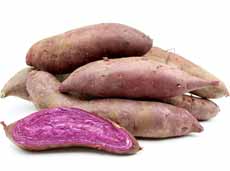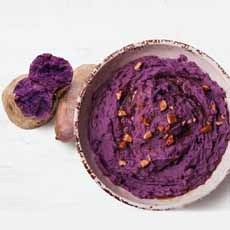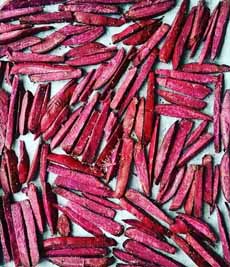TIP OF THE DAY: Stokes Purple Sweet Potatoes
|
Purple may not be a theme color for the holidays, but we can’t resist the Stokes purple sweet potatoes that are in markets now. Once a rarity outside of Asian markets, purple potatoes are now popping up in mainstream markets nationwide. There are different varieties, which vary in shape and levels of moisture, density, richness and sweetness. Some are brown-skinned with purple flesh. Others, like the Murasaki sweet potato, have a lovely violet skin, but the flesh inside is white. The Filipino ube, which would seem to be part of this group, isn’t. It’s a yam, not a sweet potatoe; it grows on a vine above the ground, as opposed to under the soil. The deep purple color comes from several anthocyanins, antioxidant pigments found in blueberries, cherries, red cabbage, strawberries, and other fruits and vegetables their color. Note that not all blue-purple-red produce colors are from anthocyanins. Beets, for example, get their color from betalains, other pigments. Stokes potatoes are veiled in mystery. They were propagated by Mike Sizemore a grower in Stokes County, North Carolina, the nation’s largest sweet potato-producing state (who knew?). He relates that one day in 2003, when he won a prize for his sweet potatoes at a state fair, an unidentified woman approached gave him some deep purple sweet potatoes. At the time, there were already other purple-fleshed sweet potatoes on the market, including the Okinawan sweet potato, also known as the Hawaiian sweet potato and uala. Under its light beige-colored skin is violet-purple flesh. Sizemore did not know the origin of the dark-skin potatoes he was handed, but propagated them and found that the potatoes kept their deep color remarkably well when cooked. He obtained a patent on the potato and started marketing it commercially in 2006. In 2013 he licensed it to California’s largest sweet potato grower and distributor, and that company is now selling it exclusively through specialty produce distributor Frieda’s [source]. We are big fans. The Stokes are moister, have more density, and better color when cooked, than Okinawan sweet potatoes. They has a rich, almost winy flavor. You can substitute them in any sweet potato, and many white potato, recipes. Mashed or french-fried, they’ll have more eye appeal than anything else on the plate. Truth to tell, when we first brought home a bag, we couldn’t wait to eat them. We popped them in the microwave for 4-5 minutes. The potatoes were long and relatively slender; they emerged moist and delicious. We didn’t even need to add butter! Here are tips from Frieda’s: |
|
|
|
The Stokes Purple sweet potato can be prepared like most sweet potatoes; however, their lower moisture content should be taken into account. Adding one or two tablespoons of liquid to the recipe will achieve a more desirable consistency. Millennia ago, thousands of varieties of potatoes grew wild in the foothills of the Andes Mountains of Peru. Scores of varieties were cultivated around 3,000 B.C.E. by the Incas, including those with the pigments that create blue- and purple-fleshed white potatoes and purple sweet potatoes. Today, purple potatoes are grown around the world. Here’s more about purple potatoes and a recipe for a colorful purple potato and beet salad. Here’s a brief history of potatoes.
|
||






